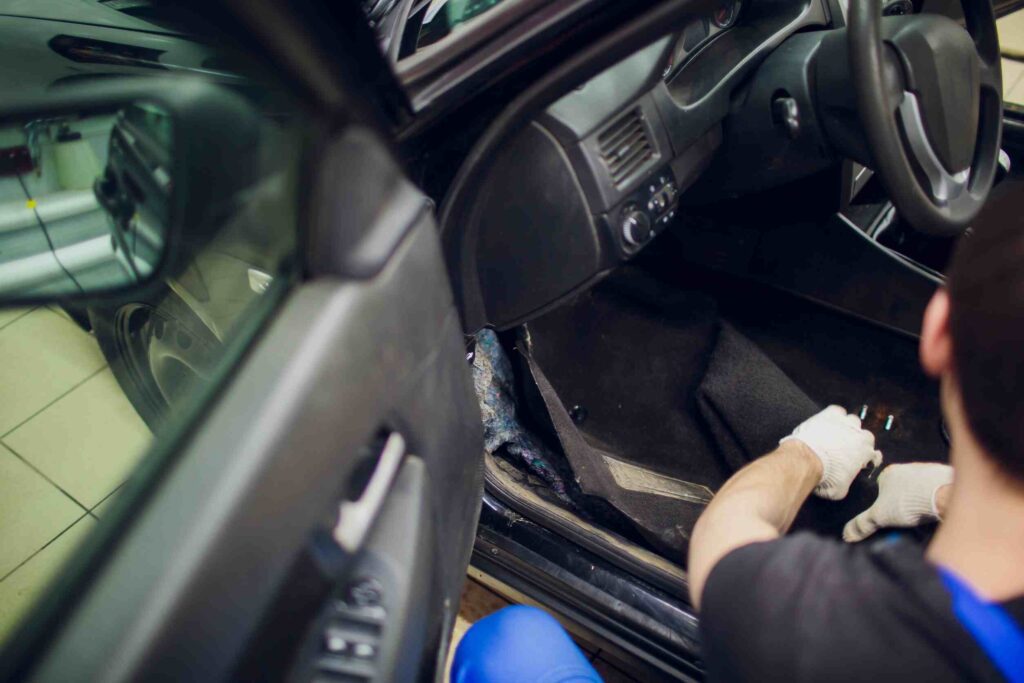Have you ever stepped into your car only to be greeted by an unexpected puddle on the floor? It’s a mysterious occurrence that is more common than you might think. The good news is this article has all the reasons, how to diagnose each problem, and how to fix them.
Is a Wet Car Floor a Problem?
Before we get into the reasons why you may have a wet car floor, I want to point out that a wet car floor is problematic for a few reasons:
- Water damages electronics – Depending on how the water is getting into the vehicle, it may be running down wiring entering the cabin fuse box; it can also cause damage to safety features such as airbags and alarms.
- Mold growth – A damp car interior is a perfect breeding ground for mold. Mold will quickly consume a car’s interior, and it’s not easy to get rid of. Breathing in the mold is not good for you or your passenger’s health either.
- Windshield fog – When you have a lot of water inside a car, you tend to experience much more condensation inside the windshield. This doesn’t help visibility and adds to the water gathering in the foot well.
8 Reasons Why Your Car Floor Is It Wet
Regardless of why the car floor is wet, there is two main reasons for this happening:
- Rain water is leaking in.
- Something carrying water inside the cabin is leaking.
Before you read some of the reasons, one or two might not be relevant to your situation. For example, if it’s not raining, it can’t be rain getting in through weather stripping. But, if the car floor is only wet when or after it rains, it’s probably not going to be an AC drain tube causing the problem.
Leaking weather stripping
Around each door and the trunk is weather stripping, there to stop water and the wind from getting into the cabin. Weatherstripping is usually only constructed of a rubber or foam that gets damaged, chips away, falls off, or shrinks with age. You’ve probably seen a piece hanging from someone’s car door before.
Without the weather strip intact, rainwater can seep in and run down the body panels on the inside of the car, which will collect as a puddle on the floor.
Depending on why the weather stripping is causing a leak, it may be possible to clip it back into position or glue it in place. However, if the strips are damaged with chunks missing or so old it shrunk, and there is now a gap in it, you will need to replace them; they clip on and off in most cars, so there is no need to involve a mechanic for this type of repair.
Clogged sunroof drains
Most sunroofs have a drainage system to channel rainwater away from the roof and down to the ground. Typically, they consist of two or four plastic drain tubes, one at each corner of the sunroof.
Dirt, debris, leaves, and twigs can all cause a blockage in the drain tubes. This is not much of a problem until it rains and the water backs up. Once the drain tubes are full, the water will overflow and follow the interior roof structure or wiring harnesses until it reaches the car floor’s lowest point. This is regardless of if the sunroof is shut or not.
It’s pretty easy to spot the problem. If you open the sunroof, you will visibly see the drain tubes and the water backed up. You can generally clear the blockage by pushing a piece of wire or blasting compressed error down the sunroof drain tube until the blockage clears.
Poorly sealed antenna grommet
This isn’t something that modern cars have a problem with; most don’t have an antenna. But on older vehicles, the radio antenna seals around the bodywork with a rubber or foam washer. With age, this washer deteriorates, and water seeps in. It will take a while, but on a rainy day, the water will seep in and run down behind plastic trim until it collects on the car floor, soaking the carpet.
You can normally solve this problem by putting some silicone sealant around the base of the antenna.
Leaking window seals
Window seals are slightly different from the door weather stripping as they do the job of weather protection; they also act like a wiper blade when you roll down the windows, cleaning the water from the glass before it retracts into the door. These strips or seals are pretty easy to damage, especially with open windows. If a small gap appears in the window seal, water will seep through the inside of the door when it rains. It will run down until it reaches the car floor.
Unless the window seal is hanging off, it will take a long time to soak the carpet, so unless you’re out in a thunderstorm, it probably won’t be a large puddle on the floor of the car but a few drops. You can usually see the water dripping from the bottom of the door, but it sometimes takes removing the door card to see exactly where the water is getting in. Window seals can be changed but aren’t easy to fit with the window still in place. Sometimes, you can manipulate the window seal where it’s damaged back into shape with a flathead screwdriver.
Leaking heating core
The heater core, or heater matrix as they are known, is a small radiator behind the dashboard; it is fed coolant from the engine via pipework that goes through the firewall (the metal that separates the cabin and engine bay). The hot coolant inside the heater core transfers hot air, which is then blown into the car interior when you turn the blowers on.
The heater core usually fails with age or corrosion, just like a car radiator. There are certain cars I won’t mention names (you’ll know if you have one) that I won’t say have design faults, but the heater cores tend to fail regularly. Once the heater core develops, a small leak coolant drips until it reaches the car floor.
You can usually tell it’s coolant by the sweet smell it gives off, or if it’s cold, you can feel the difference between coolant and rainwater. You can also back this up by checking the coolant level, which will most likely have dropped, and then inspecting the heater core for evidence of a leak. Also, if it hasn’t rained for a while and you have a wet floor, it’s a good place to start looking for a leak.
Replacing a heater core is not a simple job that often requires draining the coolant system and removing the dash to get to it. So this might be a job best left to a qualified mechanic.
Damaged or blocked windshield cowl
The windshield cowl or scuttle panel is the plastic panel you can see between the windshield and the hood. Underneath are the wiper motor, linkage, fuse box, and battery in some cars. It is designed with channels and vents to direct rainwater away, stopping it from dripping into the engine bay and thus entering the car interior.
When you pop the hood, you will often see the underside of the cowl full of leaves and debris in the channels designed to allow rainwater out. If the channels become blocked, the water can’t escape, and instead, it drips down the firewall; it can then enter the car’s interior through deteriorated rubber grommets and wiring.
This type of problem doesn’t happen often and is extremely easy to solve by removing all the debris from underneath the cowl, specifically in the channels at the edges. Occasionally, the windshield cowls get damaged from debris or when removed to carry out other repairs. This can also explain why water is getting into the car’s interior, but this is always pretty obvious, and again, this is straightforward to sort by replacing the cowl.
Blocked AC drain tube
When you turn on the AC, it cools the air by removing moisture, resulting in condensation forming on the evaporator. This excess moisture needs to be drained away, and that’s where the AC drain tube comes in. It’s designed to carry and expel the condensation outside the vehicle. You’ll have possibly seen water dripping from a tube underneath a car on a hot day.
When the AC drain tube becomes clogged with debris, such as dirt, dust, or even mold, it cannot drain the moisture when the AC is in use. As a result, this excess moisture will overflow into the vehicle’s interior, often pooling on the passenger side floor due to the AC unit’s location in most vehicles.
You can usually take the drain tube out on most cars, but car depending they can be tricky to get to. But once you have it off the car, you can clear the blockage by poking some wire or something similar through it.
Leaking rear window washer pipe
Every car is slightly different, but the rear window washer jet has a pipe running from the engine bay’s windshield washer tank to the top of the rear window. Car depending the washer tube can run along the car’s floor or above the roof lining.
These pipes don’t fail all the time. However, the connectors go brittle with age, or a build-up of crud around one the plastic connectors can force the tube to pop off with pressure build-up. This means the water leaks out of the pipe every time you press the rear wiper washer. Depending on where these connectors or the pipes run, this could mean the water runs down channels till it soaks the car floor. Another popular place water can gather when the rear washer pipe is to blame is in the trunk, where the spare wheel is.
These aren’t easy to repair; sometimes, it means following the pipework from the engine bay until you find the leak. However, the good news is a lot of the time, it’s just a case of replacing the connector or reattaching it to the spray nozzle on the trunk lid, and the problems are solved.

Drying Car Floors
Once you have found and repaired the cause of water soaking the car floor, as I’ve already touched on, you must dry the car interior. Mold will take over, making being in the car unpleasant.
On a very hot day, this can be done by opening all the car doors and leaving the car to air out. You might need to do this over a few days, but minimal effort is involved. However, if it’s not a hot day, you should consider removing the carpet; unfortunately, this is not the easiest of jobs and usually means removing the seats. But once out, hang up to dry in a warm room; it will take a few days. You can also use an old towel to mop up any water left in the footwells.
Alternatively, an good wet vac extractor can suck out a lot of the water from the carpet; you will probably have to do quite a few passes over the floor to get it relatively dry. It’s best if you do this with the carpet removed. But if you do it with the carpet in place, you can finish the drying off by letting the car idle and pointing the heating on at the footwell.
Final Words
Although a wet car floor might cause some panic, it’s straightforward to diagnose and solve, as this article pointed out. Once you’ve applied the necessary fix, you must dry out the car’s interior asap. You do not want mold growing in the car!









